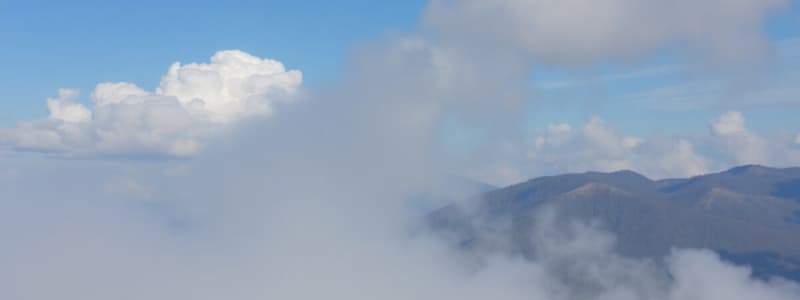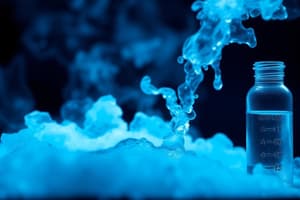Podcast
Questions and Answers
What is the primary factor affecting the saturation level of air concerning water vapor?
What is the primary factor affecting the saturation level of air concerning water vapor?
- Wind speed
- Humidity
- Air temperature (correct)
- Air pressure
Which atmospheric layer contains approximately 90% of the total atmospheric water vapor?
Which atmospheric layer contains approximately 90% of the total atmospheric water vapor?
- Stratosphere
- Thermosphere
- Troposphere (correct)
- Mesosphere
What percentage of incoming shortwave solar radiation is absorbed by water vapor?
What percentage of incoming shortwave solar radiation is absorbed by water vapor?
- 80%
- 60%
- 70% (correct)
- 50%
Which greenhouse gas is primarily affected by human activities such as burning fossil fuels?
Which greenhouse gas is primarily affected by human activities such as burning fossil fuels?
What is the bond angle between the two hydrogen atoms in liquid water?
What is the bond angle between the two hydrogen atoms in liquid water?
How many varieties of water molecules can exist due to the isotopes of hydrogen and oxygen?
How many varieties of water molecules can exist due to the isotopes of hydrogen and oxygen?
What type of bonds exist between the hydrogen and oxygen atoms in water?
What type of bonds exist between the hydrogen and oxygen atoms in water?
What percentage of outgoing long-wave radiation is absorbed by water vapor?
What percentage of outgoing long-wave radiation is absorbed by water vapor?
What primarily comprised the primitive atmosphere of the Earth?
What primarily comprised the primitive atmosphere of the Earth?
What major factor contributed to the loss of the primitive atmosphere?
What major factor contributed to the loss of the primitive atmosphere?
Which gases were mainly released during the formation of the secondary atmosphere?
Which gases were mainly released during the formation of the secondary atmosphere?
Which process leads to the formation of nitrogen in the atmosphere?
Which process leads to the formation of nitrogen in the atmosphere?
What role did the oceans play in the evolution of the Earth's atmosphere?
What role did the oceans play in the evolution of the Earth's atmosphere?
What charge do hydrogen atoms acquire in a water molecule?
What charge do hydrogen atoms acquire in a water molecule?
What is the maximum number of hydrogen bonds that water can form?
What is the maximum number of hydrogen bonds that water can form?
What was the outcome of the cooling process of the Earth after the secondary atmosphere was formed?
What was the outcome of the cooling process of the Earth after the secondary atmosphere was formed?
What method contributed to the formation of oxygen in the atmosphere?
What method contributed to the formation of oxygen in the atmosphere?
Why does ice float on water?
Why does ice float on water?
What was a significant characteristic of the secondary atmosphere when it formed?
What was a significant characteristic of the secondary atmosphere when it formed?
What is the specific heat of water?
What is the specific heat of water?
What effect does temperature have on vapor pressure?
What effect does temperature have on vapor pressure?
What is the latent heat of fusion for water?
What is the latent heat of fusion for water?
How does the addition of solutes like salt affect the vapor pressure of water?
How does the addition of solutes like salt affect the vapor pressure of water?
What is a property of water that makes it an excellent solvent?
What is a property of water that makes it an excellent solvent?
What percentage of the Earth's crust by weight comprises inorganic components?
What percentage of the Earth's crust by weight comprises inorganic components?
Which of the following is NOT a primary mineral?
Which of the following is NOT a primary mineral?
What is an example of a secondary mineral?
What is an example of a secondary mineral?
Soil organic matter excludes which of the following?
Soil organic matter excludes which of the following?
Where are secondary minerals primarily found in soil?
Where are secondary minerals primarily found in soil?
What defines the principal cations responsible for hardness in water?
What defines the principal cations responsible for hardness in water?
Which factor contributes to the formation of hard water?
Which factor contributes to the formation of hard water?
What primary focus did soil chemistry have before its expansion into environmental concerns?
What primary focus did soil chemistry have before its expansion into environmental concerns?
Which of the following components is NOT part of the inorganic portion of soil?
Which of the following components is NOT part of the inorganic portion of soil?
What term describes the smallest unit that can be considered as 'soil'?
What term describes the smallest unit that can be considered as 'soil'?
What important study has emerged due to concerns over contaminants in soil and water?
What important study has emerged due to concerns over contaminants in soil and water?
Which elements are primarily found in soils in the highest quantities?
Which elements are primarily found in soils in the highest quantities?
How do peds form in soil?
How do peds form in soil?
What process contributed to the formation of oxygen in the early atmosphere?
What process contributed to the formation of oxygen in the early atmosphere?
Which organisms were primarily responsible for the initial release of oxygen into Earth's atmosphere?
Which organisms were primarily responsible for the initial release of oxygen into Earth's atmosphere?
What is the main reason that 97% of Earth's water is unusable for drinking and agriculture?
What is the main reason that 97% of Earth's water is unusable for drinking and agriculture?
What term refers to pollutants that have a direct influence on bodies of water?
What term refers to pollutants that have a direct influence on bodies of water?
Which statement about polar bonds in water is correct?
Which statement about polar bonds in water is correct?
What does soil organic matter, also known as humus, comprise?
What does soil organic matter, also known as humus, comprise?
Which branch of science focuses on the chemical composition and properties of soils?
Which branch of science focuses on the chemical composition and properties of soils?
What distinguishes in situ techniques from non-in-situ techniques for decontaminating soils?
What distinguishes in situ techniques from non-in-situ techniques for decontaminating soils?
Flashcards
Primitive Atmosphere
Primitive Atmosphere
The Earth's early atmosphere, primarily composed of hydrogen, helium, ammonia, and methane.
Secondary (Reducing) Atmosphere
Secondary (Reducing) Atmosphere
Earth's atmosphere after the primitive one, composed mostly of water vapor, carbon dioxide, and ammonia, released by volcanic activity.
Oxidizing Atmosphere
Oxidizing Atmosphere
The atmosphere after the reducing atmosphere, where oxygen increased
Formation of oceans
Formation of oceans
Signup and view all the flashcards
Nitrogen Formation
Nitrogen Formation
Signup and view all the flashcards
Photochemical Dissociation
Photochemical Dissociation
Signup and view all the flashcards
Early Atmosphere Composition
Early Atmosphere Composition
Signup and view all the flashcards
Earth's atmosphere now
Earth's atmosphere now
Signup and view all the flashcards
Water Hardness
Water Hardness
Signup and view all the flashcards
Soil Chemistry
Soil Chemistry
Signup and view all the flashcards
Environmental Soil Chemistry
Environmental Soil Chemistry
Signup and view all the flashcards
Soil Composition
Soil Composition
Signup and view all the flashcards
Pedons
Pedons
Signup and view all the flashcards
Soil Profiles
Soil Profiles
Signup and view all the flashcards
Water pH
Water pH
Signup and view all the flashcards
Inorganic Soil Components
Inorganic Soil Components
Signup and view all the flashcards
Hydrogen Bond
Hydrogen Bond
Signup and view all the flashcards
Coordination Number
Coordination Number
Signup and view all the flashcards
Specific Heat of Water
Specific Heat of Water
Signup and view all the flashcards
Latent Heat of Fusion
Latent Heat of Fusion
Signup and view all the flashcards
Latent Heat of Vaporization
Latent Heat of Vaporization
Signup and view all the flashcards
Vapor Pressure
Vapor Pressure
Signup and view all the flashcards
Boiling Point (affected by vapor pressure)
Boiling Point (affected by vapor pressure)
Signup and view all the flashcards
Water's Excellent Solvent
Water's Excellent Solvent
Signup and view all the flashcards
Water Vapor in Atmosphere
Water Vapor in Atmosphere
Signup and view all the flashcards
Saturation Level
Saturation Level
Signup and view all the flashcards
Greenhouse Gas (Water Vapor)
Greenhouse Gas (Water Vapor)
Signup and view all the flashcards
Carbon Dioxide (CO2)
Carbon Dioxide (CO2)
Signup and view all the flashcards
CO2 Increase Causes
CO2 Increase Causes
Signup and view all the flashcards
Water's Chemical Formula
Water's Chemical Formula
Signup and view all the flashcards
Polar Bonds in Water
Polar Bonds in Water
Signup and view all the flashcards
Water's Molecular Structure
Water's Molecular Structure
Signup and view all the flashcards
Primary Mineral
Primary Mineral
Signup and view all the flashcards
Secondary Mineral
Secondary Mineral
Signup and view all the flashcards
Soil Organic Matter (SOM)
Soil Organic Matter (SOM)
Signup and view all the flashcards
Inorganic Components
Inorganic Components
Signup and view all the flashcards
Mineral
Mineral
Signup and view all the flashcards
Ozone Layer
Ozone Layer
Signup and view all the flashcards
Cyanobacteria
Cyanobacteria
Signup and view all the flashcards
Water's Polarity
Water's Polarity
Signup and view all the flashcards
Usable Fresh Water
Usable Fresh Water
Signup and view all the flashcards
Water Pollutants
Water Pollutants
Signup and view all the flashcards
Point Source Pollution
Point Source Pollution
Signup and view all the flashcards
Non-Point Source Pollution
Non-Point Source Pollution
Signup and view all the flashcards
Study Notes
The Chemistry of the Environment
- Our environment encompasses air, land, water, and climate
- Chemistry is crucial for understanding, monitoring, protecting, and improving the environment
- Chemists develop tools to measure and track pollution
- They study how climate has changed over time
Formation of the Atmosphere
- Primitive Atmosphere (4.5 billion years ago): Primarily hydrogen and helium, with ammonia and methane
- Strong Solar Winds: Removed the early atmosphere due to the lack of a magnetic field
- Secondary Atmosphere (formation of the solid crust and active volcanoes): Primarily water vapor, carbon dioxide, ammonia
- Condensation and Ocean Formation: Water vapor cooled, clouds formed, and oceans absorbed significant carbon dioxide
- Nitrogen Formation: Ammonia broke down to create nitrogen through sunlight
- Other Gases: Hydrogen, methane, carbon monoxide, hydrogen sulfide, sulfur dioxide, and chlorine
- Oxidizing Atmosphere: Formation of oxygen from the photochemical dissociation of water vapor, though the amount produced is negligible
- Photosynthesis: Cyanobacteria released significant oxygen as a byproduct of this process
Importance of Atmospheric Gases
- Nitrogen: Essential for all living systems, involved in the nitrogen cycle.
- Oxygen: Fundamental for life, exchanged between the atmosphere and biosphere through photosynthesis and respiration.
Studying That Suits You
Use AI to generate personalized quizzes and flashcards to suit your learning preferences.




